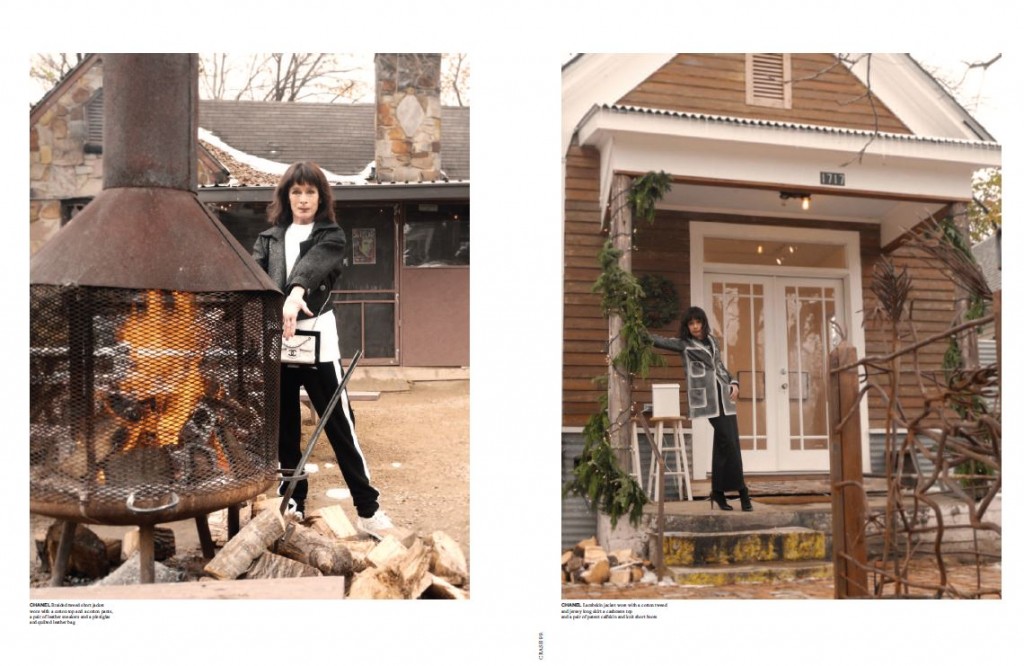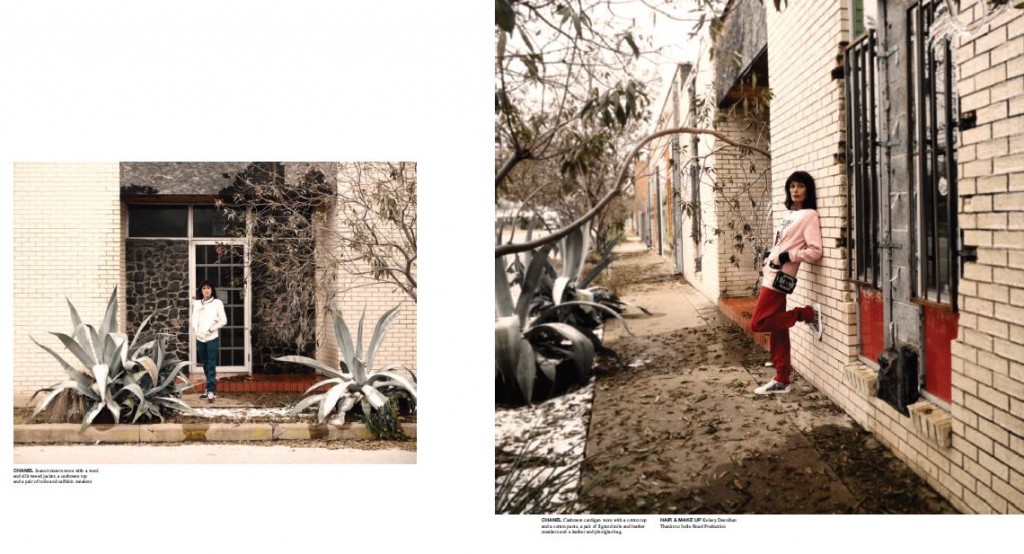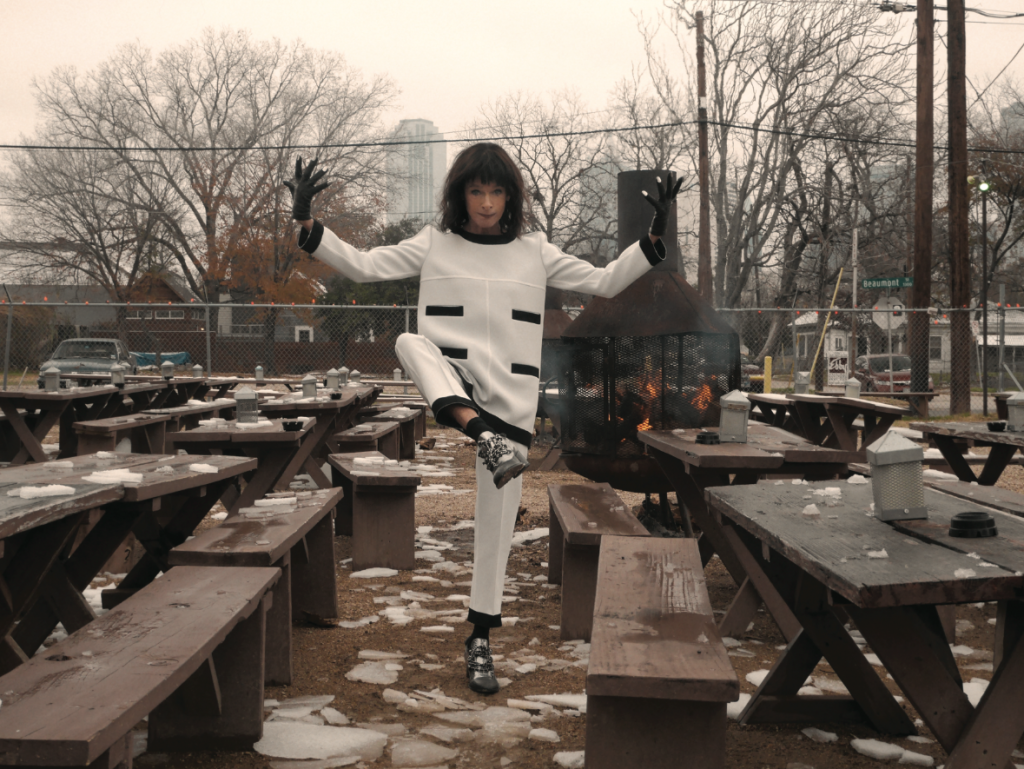
GERALDINE CHAPLIN ON UTOPIA
By Crash redaction
METAMORPHOSED INTO MADEMOISELLE CHANEL FOR KARL LAGERFELD’S LATEST FILM, “THE RETURN,” WHICH PREMIERED IN DALLAS FOR THE OPENING OF CHANEL’S 2013-2014 MÉTIERS D’ART SHOW, GERALDINE CHAPLIN IS A FORCE TO BE RECKONED WITH ON SCREEN. BUT IT’S WITH THE BRIGHT EYES OF A LITTLE GIRL THAT SHE NARRATES FOR US THE STORY OF HER UNIQUE CAREER. TEEMING WITH GRACE, SHE LAUGHS OFF THE IDEA OF AGE AS WELL AS INNOCENCE. AND THROUGH THE VEIL OF HER SOPHISTICATED SENSE OF HUMOR, SHE ALSO TOSSES US A FEW PEARLS OF WISDOM GLEANED OVER A LIFE OF LUCK AND GLAMOROUS ENCOUNTERS.
What was it like to work with Karl and Chanel?
The first time we met was on the first day of shooting. My niece Carmen was at the Cannes Film Festival last May. And she sent me an email saying Karl Lagerfeld wanted to
do a film with me as Coco Chanel at age 70… I thought she was just teasing me. But she gave my contact info to the right person and the whole thing materialized shortly
thereafter. Though the details were never specified. I kept asking my contacts if they had any more info, and they kept telling me, “Next week, next week” or “Karl will call
you.” But nothing happened! Karl Lagerfeld is one of my idols, though more for his persona than his art. I’ve always thought he was brilliant, so I was anxious to meet him. But he never called. In the meantime my plane ticket came and I went to Paris. When I got to the hotel, I found out I had the best room and that he had left one hundred roses for me! Anyway, they told me they hadn’t written the script for the film yet. Then at around eleven on the night before the shoot – after I had already had a couple glasses of champagne – along came eleven pages that I had to memorize for the next morning! (Laughs) So I drew a bath and learned everything that night. The next day I finally met Karl. I could barely stand up straight: he was even more marvelous than I had imagined! He’s an exceptional person.
How did the shoot go?
Karl was always very elegant with his black sunglasses. Though black sunglasses are typically a barrier, with him they’re part of his appeal. Before each shot he would give me pages and pages of new dialogue he had written. My work was even more intense since I didn’t know anything about Coco Chanel’s life before the film. The only book I could find to get some info was “Sleeping with the Enemy,” which doesn’t provide a very comprehensive image of her life. But the shoot was even more impressive because the team was incredible and full of energy! Some of the world’s best makeup artists and hair stylists were on set. And then there were all those beautiful girls, like so many orchids… I don’t really go to fashion shows or any other fashion events, so I was just stunned the whole time! And the crew really worked their magic and turned me into Chanel. Karl rarely said a word, but he had extremely high expectations, of course. What I most admire about him is that he works very hard. And so do I. Since I never heard them say “cut,” I just kept going… Improvising! So the days were very long. We were all wondering who would run out of energy first: him or me. But neither of us did! We would do a few rehearsals, until Karl got a new idea. It was total creativity on his part, and total obedience on mine. I wanted to give him everything he wanted.
How is Karl Lagerfeld different from typical directors?
He certainly has his own way of filming. Karl has an unshakeable faith in his own inspiration. He knows he’s a genius. Managing a big team and directing a bunch of actors may seem like a very social job, but in the end I think the work is a lot more solitary than that. Actors always want to do things their own way, while the technicians are always trying to showcase their own talents above all else… So in the end the director is kind of alone in trying to manage all these people. Karl had a lot faith in himself. But sometimes he would stop and ask me: “Did I do a good job on this scene?” And of course he had! Despite all the mystery he cultivates, he still seemed to be extremely attentive and aware of everything going on around him.
How did you prepare for the role since you had so little information?
The only thing I knew about Chanel was an evening gown I inherited from my mother. So to prepare I watched all the major interviews Chanel gave throughout her life. She had a very strong personality. She was brilliant, but she also had some edge. And I was pretty good at imitating her tone and style… in French at least. The only problem was that the film was in English! So I had to take it one step further. I also looked very closely at Karl’s last film, with Keira Knightley as Coco Chanel. I didn’t realize how these films were something of an annual event. It’s the person I worked with right after who filled me in. I didn’t understand the magic of it at all. When I told her about the project, her eyes lit up. She told me all the names of the top models I had just worked with: Stella Tennant, Cara Delevinge who played Romy Schneider… On set Karl explained to each of us all the backstory of our characters. What a memory! And the girls were breathtaking. Another amazing thing: people who actually work alongside Karl at Chanel were on set and had parts in the film. So there were a bunch of extremely talented master craftspeople working with us. It was nervewracking being around all these highly skilled fashion people, since I didn’t really know what I was doing. Luckily the only reason Chanel touches a pin in the film is to torture her models!
Can you tell us anything about the story?
Coco Chanel gives her first fashion show in 1953, after having stayed quiet for several years. It turns out to be a disaster, but it takes just one person who believes in her to keep her going. An American girl simply tells her: “You’re a genius.” And then she reinvents herself and designs some of her most iconic items. Her next show is a total success:
Chanel is back. The film was shot in Chanel’s old apartment on Rue Cambon. Nothing had been changed in the apartment. So with the set, the Chanel employees, and all those wonderful dresses from the era, the film has an extremely realistic effect. It was a unique experience.
What have you worked on since then?
I’ve been really busy lately. I like to say that the more wrinkles I get, the more work I get, too! Grandmothers, horror films… I do them all, because no one else is getting wrinkles
nowadays! (Laughs) I just finished shooting a film with Israel Cardenas and Laura Amelia Guzman. They’re two young directors whose first film, “Jean Gentil,” won an award at the Lima Film Festival. It was a film that left a deep impression on me, and I was thrilled to be a part of their new project. I also did “Panda Eyes,” directed by Isabel Coixet. I really admire her because she does all her own camera work. Then I traveled to Argentina to do Eugenio Zanetti’s first film as a director. He’s just now directing his first film at 70, though he already won an Oscar for Best Art Direction on Vincent Ward’s “What Dreams May Come.” And soon I’m going to play Eleonore Roosevelt. Coco Chanel, then Eleonore Roosevelt… What a contrast!
How long have you been acting? What were your most important roles?
As a child I acted in my father’s films. My first real part was in “Doctor Zhivago.” I turned 21 on set… Let’s just say I’ve been doing this for a little while! Shooting lasted 14 months and it was all in Spain, so I became very attached to the country. I didn’t pack my bags once the entire time. And by the end I had accumulated so many things that I didn’t really know what to do or where to go. Everyone on the crew was going home, but I didn’t know where to go after Madrid. So I decided to wait and see. And now 50 years have gone by! I completely fell in love with Madrid. I ended up having my children there. For my career, my roles with Carlos Saura and Cria Cuervos were obviously very
important. In my opinion, that was Carlos’s best period, but I should add that we were very much in love at the time.
Do you think it takes courage to be an actress?
Yes, definitely! You have to put up with rejection and self-doubt. Now it’s my daughter who’s going through all that. I told her what to watch out for at the beginning, but I think she’s doing a marvelous job: she’s truly a great actress. The people I admire most in the industry are Jane Fonda, who is one of my good friends, and Jane Birkin. We worked together on three films and I think she’s an exceptional person. I might even say I love her! I started out wanting to be a dancer. I was convinced I was a great dancer, though it wasn’t exactly true. I did some work here and there, dancing in a few cabarets. And then I thought: “Why don’t I do some acting?” I was lucky because my first film, “Crime on a Summer Morning” with Jean-Paul Belmondo, opened a lot of doors for me right away. And luck is the most important thing in this business. You certainly need talent, but a lot of talented people never have any luck. It’s not fair, but that’s what it takes. Me, I’m lucky.
“THE RETURN”
by Karl Lagerfeld
with Geraldine Chaplin,
Rupert Everett, Anna Mouglalis









